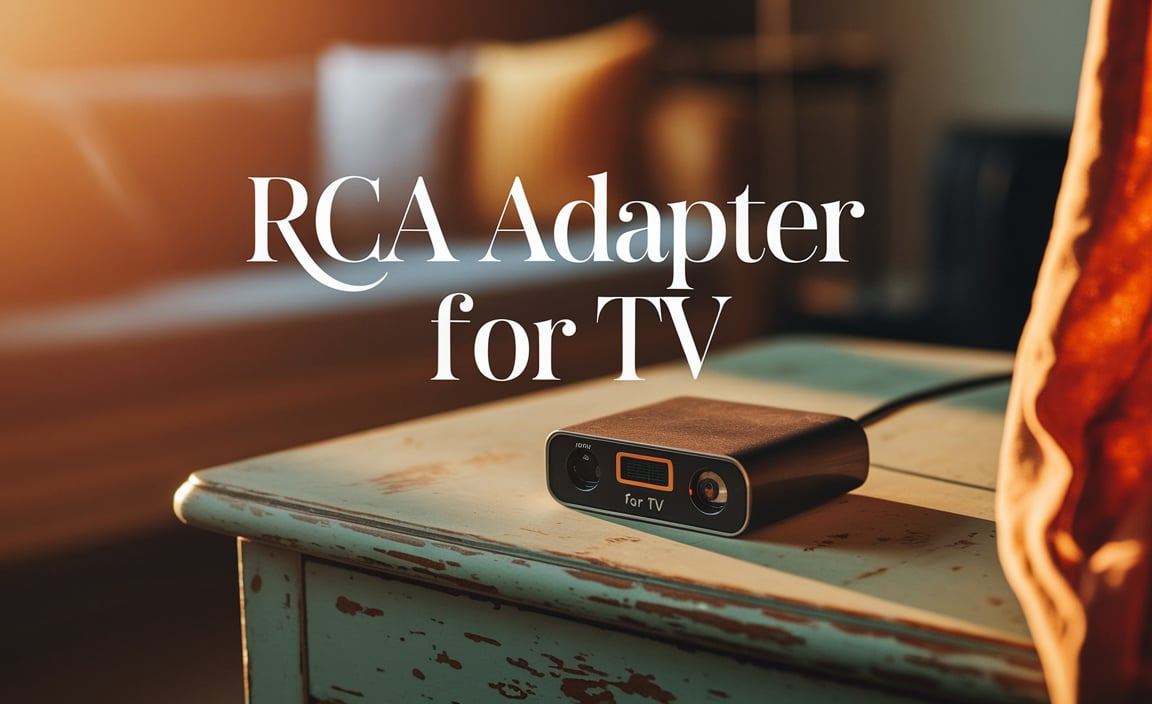Quick Summary
Is your Shark robot vacuum losing power or stopping mid-clean? Replacing the battery is likely the solution. This guide will help you easily find the right replacement battery for your Shark robot vacuum, understand installation, and get it back to cleaning your floors efficiently.
We all love our robot vacuums, especially those handy Shark models that keep our homes spotless. But what happens when your trusty cleaning companion starts losing its steam? If your Shark robot vacuum is suddenly dying before it finishes its job, or struggling to return to its dock, the battery might be the culprit. It’s a common issue as these hardworking batteries age, but don’t worry! Replacing it is often simpler than you think. This guide is here to walk you through everything you need to know, so you can restore your vacuum’s power and get your floors sparkling again without any hassle.
Why Your Shark Robot Vacuum Needs a Fresh Battery
Over time, all rechargeable batteries degrade. Think of it like a smartphone – the more you use it and charge it, the less time it holds a charge. The battery in your Shark robot vacuum is no different. It works hard, day in and day out, powering the motors, brushes, and navigation systems. After a few years of dedicated service, it’s natural for its capacity to drop.
When a Shark robot vacuum battery starts to fail, you’ll notice several tell-tale signs:
- Shorter run time: The vacuum might stop cleaning after only 30-60 minutes, even when it used to run much longer.
- Difficulty returning to the dock: It might struggle to find its charging station or run out of power just before reaching it.
- Inconsistent performance: The vacuum might seem weaker, with less suction power.
- Error codes: Some models might display specific error messages related to battery performance.
- Completely stops working: It might not turn on at all, or die very quickly after being charged.
A worn-out battery isn’t just inconvenient; it can also prevent your vacuum from completing its cleaning cycles, leaving you with dust bunnies and missed spots. The good news is that replacing the battery is a targeted fix that can give your robot vacuum a new lease on life, saving you from buying a whole new machine.
Finding the Right Replacement Battery for Your Shark Robot Vacuum
This is the most crucial step. Not all batteries are created equal, and using the wrong one can damage your vacuum or be a safety hazard. Let’s break down how to find the perfect fit.
Step 1: Identify Your Shark Robot Vacuum Model
Before you search for a battery, you need to know exactly which Shark robot vacuum model you have. Shark uses different model numbers for their various lines (like ION Robot, IQ Robot, AI Robot, etc.) and within those lines, there are sub-models.
Where to find your model number:
- On the vacuum itself: Check the underside or back of your robot vacuum. It’s usually on a sticker with serial numbers and other specifications.
- In the user manual: Your original manual will clearly state the model number.
- On the charging dock: Sometimes, the model information is also printed on the charging base.
- In the SharkClean App: If you connected your robot to the app, your model name and number should be listed there.
Common Shark robot vacuum series include:
- Shark ION Robot (e.g., RV700, RV720, RV750, RV760)
- Shark IQ Robot (e.g., R100, R101AE, R200)
- Shark AI Robot (e.g., AV910, AV911S, AV970)
Once you have the model number (e.g., RV755, R101AE), you’re ready for the next step.
Step 2: Determine the Battery Type and Specifications
Once you know your model, you need to figure out what kind of battery it uses. Most Shark robot vacuums use rechargeable Lithium-ion (Li-ion) or Nickel-Metal Hydride (Ni-MH) batteries. The specifications you’ll need to match are:
- Voltage (V): This is critical. It must match the original battery.
- Capacity (mAh or Ah): This determines how long the battery will last on a single charge. Higher mAh generally means longer run time.
- Connector Type: The plug that connects the battery to the vacuum must be identical.
How to find these specs:
- Check your original battery: Carefully remove your old battery (we’ll get to how in a moment) and look for a label. it will have all the necessary voltage and capacity information.
- Consult your user manual: The manual often lists the original battery specifications.
- Search online: Use your exact Shark robot vacuum model number and search for “replacement battery specifications” or “battery type.”
Step 3: Where to Buy Your Replacement Battery
You have a few options for purchasing a replacement battery:
- Official Shark Parts: The safest bet is to buy directly from Shark or an authorized Shark parts dealer. This ensures compatibility and quality.
- Reputable Online Retailers: Websites like Amazon, eBay, and specialized battery stores often carry compatible batteries. Be sure to:
- Read reviews carefully.
- Check seller ratings.
- Verify that the battery is explicitly listed as compatible with your specific Shark model.
- Look for batteries with warranties.
- Third-Party Brands: Many brands make batteries designed to be compatible with Shark vacuums. Again, prioritize reputable brands and check compatibility thoroughly.
Important Note on Battery Types: While some older Shark models might use Ni-MH batteries, newer ones almost exclusively use Li-ion. Li-ion batteries are generally lighter, hold more charge, and have a longer lifespan. If your vacuum came with Li-ion, stick with Li-ion. If it came with Ni-MH, a compatible Li-ion battery might be available and could offer improved performance, but always double-check this possibility with the battery manufacturer for your specific model.
Factors to Consider When Choosing:
When comparing different replacement batteries, consider these:
- Price: Batteries can range from $20 to $70+, depending on brand, capacity, and where you buy it.
- Brand Reputation: Stick with brands known for quality rechargeable batteries.
- Warranty: A good warranty provides peace of mind.
- Customer Reviews: Real user experiences can highlight potential issues or confirm quality.
- Capacity (mAh): A higher mAh battery (e.g., 3000mAh instead of 2500mAh) might offer a longer run time, but ensure it’s a direct replacement in terms of voltage and physical fit.
How to Replace the Battery in Your Shark Robot Vacuum: A Step-by-Step Guide
Replacing the battery in most Shark robot vacuums is a straightforward DIY task. The exact location of the battery compartment can vary slightly between models, but the general process is very similar. Always refer to your specific model’s manual if you’re unsure.
Tools You Might Need:
Gather these before you start:
- Phillips head screwdriver: Usually a medium-sized one is sufficient for removing the battery cover screws.
- New replacement battery: Make sure you have the correct, fully charged battery.
- A clean, flat surface: To work on.
- A soft cloth: For cleaning any dust.
Step-by-Step Installation:
-
Power Off and Unplug:
Ensure your Shark robot vacuum is completely powered off. It’s also a good idea to remove it from its charging dock and unplug the dock from the wall, just to be safe.
-
Access the Battery Compartment:
Turn the robot vacuum upside down on your clean, flat surface. Look for the battery compartment cover. In most Shark models, this is located on the underside and is secured by one or two screws. For some models, the battery might be under the dustbin compartment, but it’s usually clearly marked as the battery.
Example: On many ION Robot models, you’ll see a rectangular cover held by small screws.
-
Remove the Battery Cover Screws:
Using your Phillips head screwdriver, carefully unscrew the screws holding the battery cover in place. Keep these screws in a safe place, like a small bowl or magnetic tray, so you don’t lose them. Some screws might be T-shaped if your model uses a Torx head; use the appropriate driver.
-
Remove the Old Battery:
Once the screws are out, gently lift or slide off the battery compartment cover. You should now see the old battery. It might be held in place by clips or simply rest in its compartment. Carefully lift the old battery out. There might be a small connector cable attached to it. If so, disconnect this gently – usually, they just pull straight out or have a small tab to press.
Safety First: If the battery appears swollen, leaking, or damaged, handle it with extreme care. Do not puncture it. Place it directly into a plastic bag and prepare it for E-waste disposal.
-
Install the New Battery:
Take your new, fully charged replacement battery. Align it correctly within the compartment. If there’s a connector cable, plug it into the corresponding port on the vacuum. Ensure it’s seated firmly but don’t force it. The new battery should fit snugly into place.
-
Replace the Battery Cover:
Position the battery compartment cover back over the battery. Make sure it’s aligned correctly. Then, re-insert and tighten the screws you removed earlier. Don’t overtighten them, as this can strip the screw threads.
-
Final Checks and Charging:
Turn the vacuum right side up. Place it back on its charging dock. The vacuum should indicate that it is charging. Many Shark models have an LED light or an audible cue to show charging status. Allow the new battery to charge fully (this might take a few hours) before running its first cleaning cycle.
Troubleshooting During Installation:
- Screws won’t come out: Ensure you’re using the correct screwdriver size and type. If they’re stripped, you might need a screw extractor tool.
- New battery doesn’t fit: Double-check that you ordered the correct battery for your specific model number.
- Vacuum won’t charge: Ensure the connector is plugged in properly. Make sure the charging dock is powered on and functioning.
Battery Care and Maintenance Tips for Longevity
Once you’ve replaced your battery, you want to make sure the new one lasts as long as possible. Proper care can significantly extend its lifespan and keep your Shark robot vacuum performing at its best.
Best Practices for Charging:
Modern Li-ion batteries don’t suffer as much from the “memory effect” as older Ni-MH batteries, but these tips still help:
- Always use the original or a certified charger: Using the wrong charger can damage the battery or be a fire hazard.
- Let it charge fully: While not strictly necessary for Li-ion, completing the charge cycle helps the battery management system calibrate.
- Avoid extreme temperatures: Don’t leave your vacuum or its battery in a very hot car or a freezing garage. Charge and store it in a temperate environment (ideally 50-75°F or 10-24°C).
- Don’t leave it fully discharged for too long: If you’re storing the vacuum for an extended period, try to charge the battery to about 50-80% first. Leaving a Li-ion battery deeply discharged for months can degrade it.
Optimizing Run Time:
To get the most out if each charge:
- Keep brushes and filters clean: When the vacuum doesn’t have to work as hard to pick up debris, it conserves battery power.
- Ensure clear paths: Remove obstacles like cords, rugs with tassels, or misplaced items that can tangle the brushes or make the vacuum work harder. Visit CPSC.gov for important safety recalls, including potential fire hazards which can sometimes be related to battery performance and charging, emphasizing the importance of using correct parts and maintenance.
- Map your home (if applicable): Some Shark models allow you to create no-go zones or target specific rooms. This can help the vacuum work more efficiently without wandering into areas where it’s not needed or might get stuck.
Disposing of Old Batteries Responsibly:
It’s crucial to dispose of old rechargeable batteries properly. They contain materials that can be harmful to the environment if sent to a landfill. Many electronics stores, hardware stores, and local recycling centers offer battery recycling programs. Check with your local municipality or look for resources like Earth911.com for nearby drop-off locations.
Comparing Replacement Battery Options
When you’re shopping around, you’ll see a variety of batteries. Here’s a quick look at what might differentiate them for your Shark robot vacuum:
Original Shark Battery vs. Aftermarket Battery
| Feature | Original Shark Battery | Aftermarket Battery |
|---|---|---|
| Compatibility | Guaranteed to be a perfect fit for your specific model. | Must be verified carefully against your model. |
| Quality Control | Extensive testing and manufacturer standards. | Varies by brand; look for reputable manufacturers. |
| Warranty | Typically standard manufacturer warranty. | Varies widely; check specific product details. |
| Price | Often the most expensive option. | Generally more affordable. |
| Availability | Available directly from Shark or authorized dealers. | Widespread availability online. |
| Performance Improvement | Restores original performance. | May offer slightly higher capacity for longer run times if specified. |
For most users, an original Shark battery offers the most peace of mind. However, reputable aftermarket options can be a cost-effective choice, provided you do your homework and buy from a trusted source.
Understanding Battery Capacity (mAh)
Capacity is measured in milliampere-hours (mAh). A higher mAh number means the battery can store more energy, potentially leading to a longer run time before needing to recharge.
- Standard Capacity: Many Shark batteries are around 2500mAh to 3000mAh.
- Higher Capacity: You might find aftermarket batteries with capacities of 3500mAh or even higher.
Important Consideration: While a higher mAh battery can be beneficial, ensure it’s physically the same size and has the same voltage as your original battery. A battery that’s too large won’t fit, and one with incorrect voltage can damage your vacuum. Always prioritize correct specifications over just hoping for more power.
Frequently Asked Questions (FAQ)
Q1: How often do I need to replace the battery in my Shark robot vacuum?
A: Most rechargeable batteries for robot vacuums have a lifespan of about 2-3 years, or approximately 300-500 charge cycles. This can vary depending on usage patterns, charging habits, and the specific battery chemistry.
Q2: Can I use a battery for a different Shark robot vacuum model?
A: Only if the specifications (voltage, capacity, and connector type) are identical and the physical size fits the compartment. It’s always best to get a battery specifically listed for your exact Shark model to ensure compatibility and safety.
Q3: My new battery isn’t holding a charge. What should I do?
A: First, ensure the battery is fully charged for several hours until the charging indicator on the vacuum shows it’s complete. Check that the battery is properly seated in the compartment and the connector is secure





